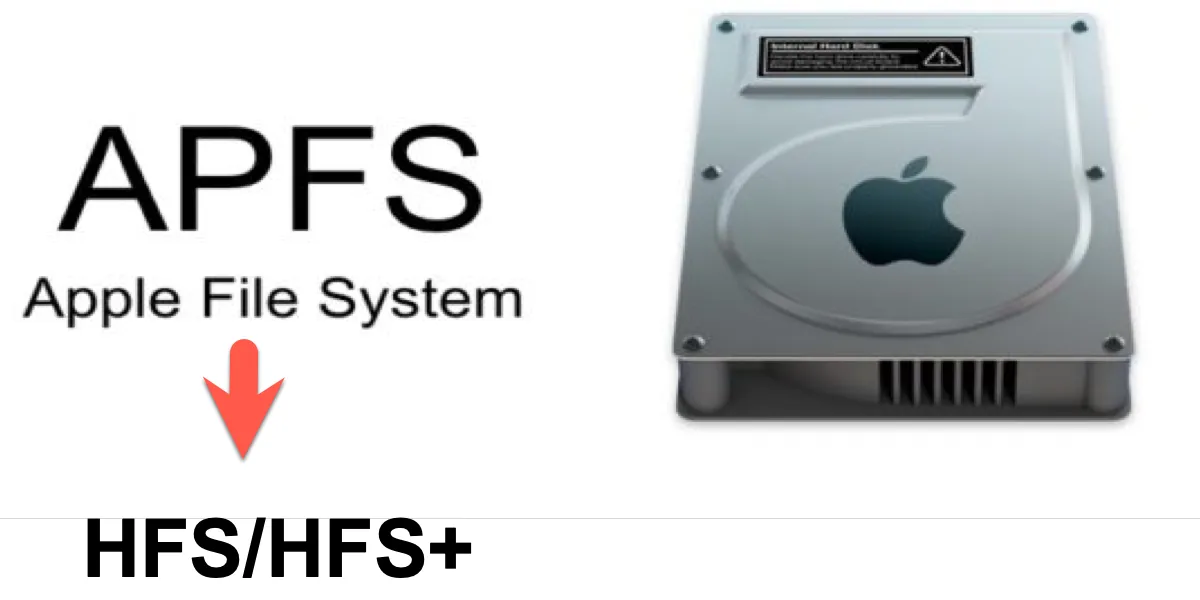I'm deciding to install macOS High Sierra on my Mac this autumn. So, if I find APFS not useful, is it possible to convert APFS back to HFS+ via Mac Terminal or using Disk utility?
If you upgrade to macOS Monterey, Big Sur, Catalina, Mojave, or High Sierra, the solid-state drive (SSD) will be automatically converted from HFS/HFS+ to APFS and there is no opt-out. However, even though the APFS file system is optimized for HFS+ with many advanced properties, many Mac users cannot get used to APFS and want to convert APFS back to HFS+. It is undeniable that APFS does come with some limitations and brings users troubles like disk corruption after converting from HFS+ to APFS.
Then you may ask, is it possible to convert/revert APFS back to HFS/HFS+? The answer is "Yes" but with some precautions. This page will list what you should know when you revert or convert APFS to HFS/HFS+ and provide the details about the best APFS to HFS converter with no risk of losing data.
Notes on converting APFS to HFS/HFS+
First, as you may have noticed, there is a new concept called container in APFS. A container is the basic storage unit for APFS and each APFS container contains one or more APFS volumes. One of these APFS volumes will have macOS and each volume could have a different APFS type: APFS, APFS (Encrypted), APFS (Case-sensitive) or APFS (Case-sensitive, Encrypted). As a result, there are some rules when you convert APFS to HFS/HFS+:
- Allowed: convert APFS container to HFS+ (also named Mac OS Extended)
- Not allowed: convert a single APFS volume to HFS+
- Not allowed: convert APFS to HFS
What's more, you need to know that converting APFS back to HFS+/HFS will format your SSD and erase all data on it. Thus, please make sure you have a backup copy of the APFS container or the whole drive. If you already backed up your data on this SSD drive, read Part 1 to learn details about how to convert/revert APFS back to HFS. Nevertheless, if you have lost something important when you convert APFS to HFS+, you can skip to Part 2 to recover lost data after the conversion from APFS to HFS+.
How to revert/convert APFS to HFS+?
Method 1: Convert APFS to HFS+ in Disk Utility
Disk Utility is a built-in tool that can manage internal and external storage devices, including partitioning and formatting your disks, creating a disk image, checking and repairing disk errors, etc. So, you can convert APFS to Mac OS Extended (HFS+) with this natural APFS to HFS+ converter - Disk Utility.
Attention: This process is destructive to your data on the APFS container/drive. So please check again if you have a backup copy.
Step 1: Go to Applications > Utilities > Disk Utility.
Step 2: Select the drive that you want to convert/revert from APFS to HFS+.
Step 3: Click Erase on the top of the Disk Utility window.
Step 4: Complete the required name, select Mac OS Extended (HFS+) as the new format and then click the Erase button.
When the process finishes, you'll get a clean HFS+ formatted drive and you can then copy back your data.
Method 2: Convert APFS to HFS+ with Terminal
The Command line, or known as Terminal in macOS, is a powerful, text-only method for interacting with your Mac computer. If you are an experienced Mac user, using macOS's built-in command line would be an appealing way to convert/revert APFS to HFS+.
Step 1: Go to Applications > Utilities > Terminal.
Step 2: Type diskutil list and find the identifier of the APFS container.
Step 3: Type diskutil eraseDisk JHFS+ 'the disk name' /dev/'the identifier'. This process will wipe all the files in this APFS container and convert it back to APFS.
How to recover lost data after reverting/converting APFS to HFS+?
If you get into problems during the process of converting APFS to HFS+/HFS, such as HFS+ partition corruption, or have lost data due to mistaken APFS to HFS+ conversion, you can recover lost data with iBoysoft Mac Data Recovery.
iBoysoft Data Recovery for Mac is the best APFS data recovery software that can recover files after failing to convert APFS to HFS+, convert HFS to APFS, recover deleted/lost data from APFS volumes, recover lost data from formatted APFS drives, recover lost data from unmountable APFS drives, recover lost data from inaccessible APFS drives, recover lost data from corrupted APFS drives, recover deleted/lost APFS volumes, etc.
Step 1: Launch iBoysoft Data Recovery for Mac.
Step 2: Choose the drive that you lost files when you converted from APFS to HFS+, click "Next" to scan for lost files on it.
Step 3: Double-click to preview the searching results and make sure the data is integrity.
Step 4: Choose files you want to get back, click "Recover" and save them.
Except for APFS data recovery, iBoysoft Data Recovery for Mac also performs effective and reliable data recovery from drives formatted with other file systems (such as HFS, HFS+, FAT32, and exFAT), as well as data recovery from formatted, unreadable, unmountable, corrupted hard drives, external hard drives, memory cards, USB drives, Pen drives, etc. It's fully compatible with macOS 12 Monterey/macOS Big Sur 11/10.15/10.14/10.13/10.12 and Mac OS X 10.11/10.10/10.9/10.8/10.7 and works fine on M1, M1 Pro, and M1 Max Mac.
Conclusion
The newest default APFS for macOS Monterey/Big Sur/Catalina/Mojave/High Sierra and later is not necessarily the best for Mac users. If you need to downgrade APFS to HFS+/HFS without data loss, backing up your data and reformatting your drive is always the safest choice, while if you are interested in new features in APFS, you can also convert HFS to APFS on Mac.
